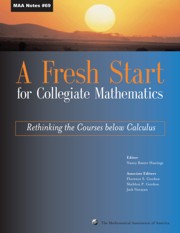Book contents
- Frontmatter
- Preface
- Contents
- Introduction
- Background
- Theme 1 New Visions for Introductory Collegiate Mathematics
- Theme 2 The Transition from High School to College
- Theme 3 The Needs of Other Disciplines
- Theme 4 Student Learning and Research
- Theme 5 Implementation
- Theme 6 Influencing the Mathematics Community
- Ideas and Projects that Work: Part 1
- Ideas and Projects that Work: Part 2
- 35 Mathematics in Action: Empowering Students with Introductory and Intermediate College Mathematics
- 36 Precalculus: Concepts in Context
- 37 Rethinking College Algebra
- 38 From The Bottom Up
- 39 The Functioning in the Real World Project
- 40 The Importance of a Story Line: Functions as Models of Change
- 41 Using a Guided-Inquiry Approach to Enhance Student Learning in Precalculus
- 42 Maricopa Mathematics
- 43 College Algebra/Quantitative Reasoning at the University of Massachusetts, Boston
- 44 Developmental Algebra: The First Mathematics Course for Many College Students
- 45 Workshop Precalculus: Functions, Data, and Models
- 46 Contemporary College Algebra
- 47 Precalculus: A Study of Functions and Their Applications,
- 48 Success and Failures of a Precalculus Reform Project
48 - Success and Failures of a Precalculus Reform Project
from Ideas and Projects that Work: Part 2
- Frontmatter
- Preface
- Contents
- Introduction
- Background
- Theme 1 New Visions for Introductory Collegiate Mathematics
- Theme 2 The Transition from High School to College
- Theme 3 The Needs of Other Disciplines
- Theme 4 Student Learning and Research
- Theme 5 Implementation
- Theme 6 Influencing the Mathematics Community
- Ideas and Projects that Work: Part 1
- Ideas and Projects that Work: Part 2
- 35 Mathematics in Action: Empowering Students with Introductory and Intermediate College Mathematics
- 36 Precalculus: Concepts in Context
- 37 Rethinking College Algebra
- 38 From The Bottom Up
- 39 The Functioning in the Real World Project
- 40 The Importance of a Story Line: Functions as Models of Change
- 41 Using a Guided-Inquiry Approach to Enhance Student Learning in Precalculus
- 42 Maricopa Mathematics
- 43 College Algebra/Quantitative Reasoning at the University of Massachusetts, Boston
- 44 Developmental Algebra: The First Mathematics Course for Many College Students
- 45 Workshop Precalculus: Functions, Data, and Models
- 46 Contemporary College Algebra
- 47 Precalculus: A Study of Functions and Their Applications,
- 48 Success and Failures of a Precalculus Reform Project
Summary
Where we started
During the years from 1988 through 1996, the authors developed a set of materials ([1], [2], and [3]) for college algebra and precalculus. Our initial discussions about teaching and writing occurred at Penn State-New Kensington, a regional campus of Penn State University. The campus has an enrollment of about 1000 students, most of whom are freshmen and sophomores. The precalculus course is populated primarily by students who plan to complete degrees in engineering, technology, or science, either at New Kensington or at Penn State's University Park campus. College algebra is often taken as a terminal course or as a prerequisite for precalculus or business calculus. Failure rates in both courses are high, and neither course has lasting value for those students who pass, but choose not to take calculus. The size of the institution and the need for transferability of credits between campuses make it difficult for an individual instructor to depart radically from prescribed course content. This limitation led us to conclude that we could improve the courses most effectively by providing innovative approaches to traditional topics.
What we planned
We wanted our materials to be flexible enough to prepare students for both traditional and reform calculus courses, and to be used by instructors with different teaching styles. Our primary goals were that each course should be a valuable educational experience in its own right, and that students should recognize the value as the course was in progress.
- Type
- Chapter
- Information
- A Fresh Start for Collegiate MathematicsRethinking the Courses below Calculus, pp. 390 - 392Publisher: Mathematical Association of AmericaPrint publication year: 2006



